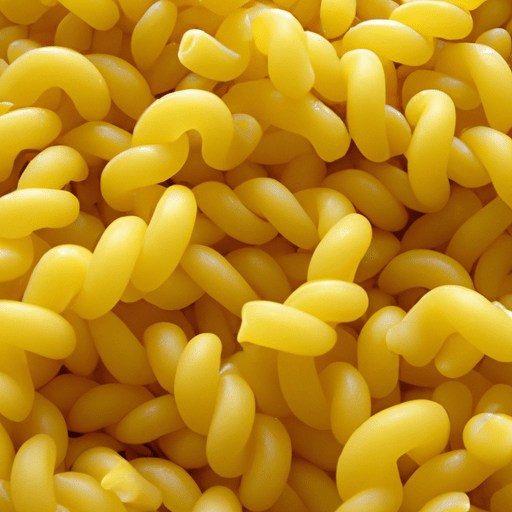The Joy of Cavatappi Pasta: Twists and Turns of Delight
If you’re a pasta lover, you probably know the joy of twirling spaghetti around your fork. But have you ever tried a pasta shape that is even more fun and whimsical? Enter cavatappi pasta, a pasta variety that truly lives up to its name. With its corkscrew-like shape, cavatappi is as playful as it is delicious. In this blog post, we’ll take a closer look at cavatappi pasta, exploring its taste, cooking applications, nutritional value, and uncovering some interesting facts about its history.
A Twist of Taste
Cavatappi, which translates to “corkscrew” in Italian, is a type of pasta that has a spiral or helical shape. Its unique structure allows sauces and flavors to cling to every nook and cranny, creating a delightful burst of taste in every bite. The texture is also something to be savored, as cavatappi is known for its firm yet chewy bite that offers a satisfying mouthfeel.
Versatility at its Best
One of the many beauties of cavatappi pasta is its versatility in the kitchen. Its spiral shape and hollow center make it perfect for capturing and holding onto a variety of sauces, from light and creamy to chunky and hearty. Due to its ability to hold up well in baked dishes, cavatappi is often used in casseroles, macaroni and cheese, and pasta salads. Its fun appearance can also make it a hit with children, encouraging them to try new dishes.
Nutritional Value
When it comes to nutrition, cavatappi pasta offers a balance of carbohydrates, protein, and fiber. As with most pasta, it is primarily made from durum wheat, which provides a good source of energy. Additionally, cavatappi contains essential minerals such as iron, magnesium, and zinc. However, it’s important to note that the nutritional value of your dish will depend on the sauce and other ingredients you pair with the pasta.
A Journey Through History
Like many pasta shapes, the origins of cavatappi can be traced back to Italy. It is believed to have originated in Southern Italy, specifically in the regions of Campania and Sicily. This popular pasta variety was traditionally handmade, with the dough being twisted around a thin rod or wire to create the distinct spiral shape. Over time, technological advancements made it possible to produce cavatappi on a larger scale, making it readily available in supermarkets worldwide.
Fun Facts
- Cavatappi is often referred to as a carnival of flavors due to its entertaining appearance and ability to hold a variety of sauces.
- In some regions, cavatappi is called scooby-doo pasta, drawing a comparison to the famous cartoon character’s spring-like tail.
- Cavatappi has gained popularity beyond Italian cuisine and can be found in fusion dishes, adding a fun twist to international flavors.
Next time you’re in the mood for pasta, consider adding cavatappi to your culinary repertoire. Its whimsical shape, versatility, and ability to hold on to delectable flavors make it a pasta worth celebrating. Whether you’re twirling it in a classic tomato sauce or incorporating it into a creative recipe, cavatappi is sure to bring joy to your kitchen and plates alike. So, go ahead, let the twists and turns of cavatappi pasta lead you on a culinary adventure you won’t soon forget!
Cavatappi Pasta
Origin: Cavatappi is a type of pasta that originated in Southern Italy. The name “cavatappi” means corkscrew in Italian, which refers to the spiral shape of the pasta.
Shape: Cavatappi is characterized by its unique corkscrew shape. It features grooves that spiral around a cylindrical tube, providing excellent sauce-holding abilities.
Common uses: Cavatappi is popular in Italian-American cuisine and is commonly used in dishes like pasta salads, macaroni and cheese, and pasta bakes. It pairs well with a variety of sauces, both creamy and chunky, due to its shape that traps sauce and ingredients.
Nutritional benefits: Cavatappi pasta, like other types of pasta, is a good source of carbohydrates, providing sustained energy. It also contains fiber, which aids in digestion. The nutritional value varies depending on the brand and the specific ingredients used to make the pasta.
Unique properties: Cavatappi’s spiral shape not only creates an aesthetically pleasing visual appeal but also helps the pasta hold onto sauces and ingredients. The grooves in the pasta allow sauces to adhere to the surface, ensuring a flavorful and satisfying bite.
Historical significance: While cavatappi pasta is not steeped in a significant historical context, its popularity has grown over the years due to its versatility and ability to complement a range of dishes. Its unique shape and texture contribute to its appeal in both Italian cuisine and modern adaptations.




Use the share button below if you liked it.
It makes me smile, when I see it.